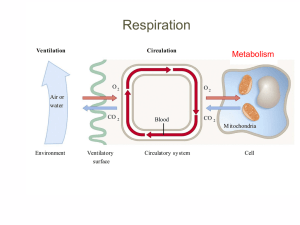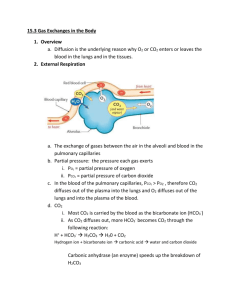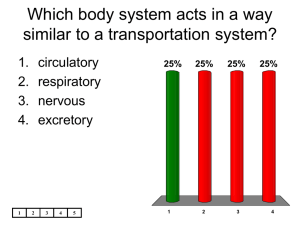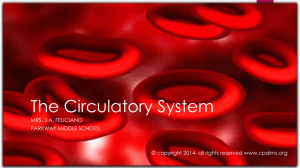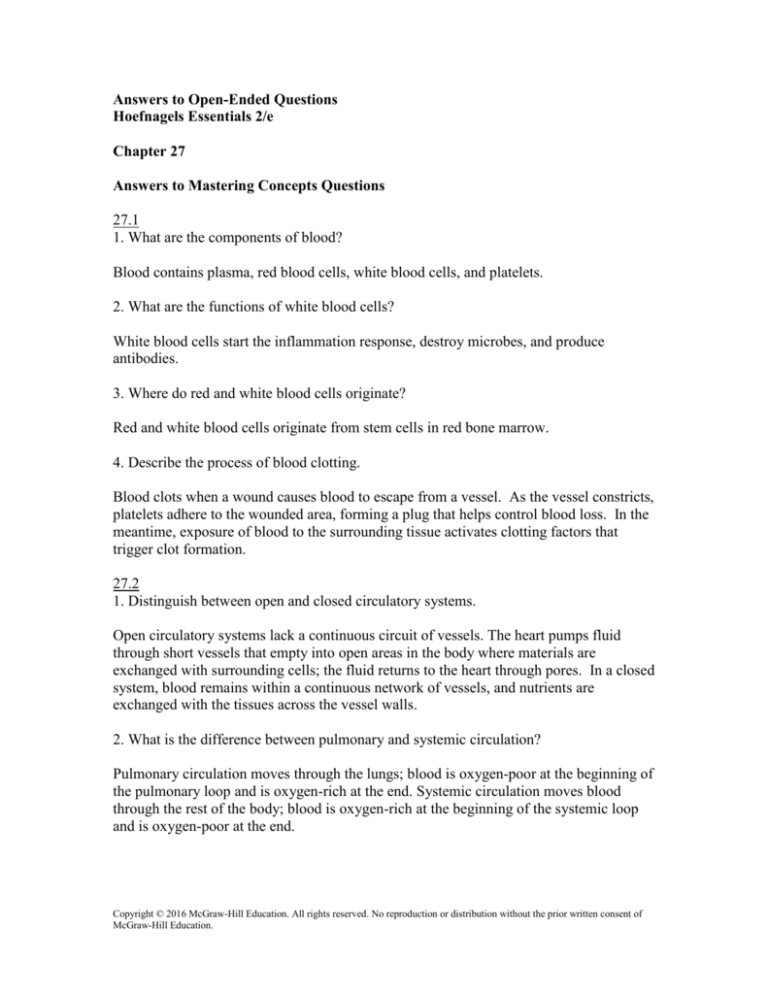
Answers to Open-Ended Questions
Hoefnagels Essentials 2/e
Chapter 27
Answers to Mastering Concepts Questions
27.1
1. What are the components of blood?
Blood contains plasma, red blood cells, white blood cells, and platelets.
2. What are the functions of white blood cells?
White blood cells start the inflammation response, destroy microbes, and produce
antibodies.
3. Where do red and white blood cells originate?
Red and white blood cells originate from stem cells in red bone marrow.
4. Describe the process of blood clotting.
Blood clots when a wound causes blood to escape from a vessel. As the vessel constricts,
platelets adhere to the wounded area, forming a plug that helps control blood loss. In the
meantime, exposure of blood to the surrounding tissue activates clotting factors that
trigger clot formation.
27.2
1. Distinguish between open and closed circulatory systems.
Open circulatory systems lack a continuous circuit of vessels. The heart pumps fluid
through short vessels that empty into open areas in the body where materials are
exchanged with surrounding cells; the fluid returns to the heart through pores. In a closed
system, blood remains within a continuous network of vessels, and nutrients are
exchanged with the tissues across the vessel walls.
2. What is the difference between pulmonary and systemic circulation?
Pulmonary circulation moves through the lungs; blood is oxygen-poor at the beginning of
the pulmonary loop and is oxygen-rich at the end. Systemic circulation moves blood
through the rest of the body; blood is oxygen-rich at the beginning of the systemic loop
and is oxygen-poor at the end.
Copyright © 2016 McGraw-Hill Education. All rights reserved. No reproduction or distribution without the prior written consent of
McGraw-Hill Education.
27.3
1. What is the cardiovascular system?
The cardiovascular system is the transportation network consisting of the heart, blood,
and blood vessels.
2. Describe the relationship among arteries, veins, arterioles, venules, and capillaries.
Arteries are the major vessels that carry blood away from the heart; they branch into
smaller arterioles, which further branch into the network of capillaries where materials
are exchanged between the blood and tissues. The capillaries converge into venules,
which converge into the veins that return blood to the heart.
27.4
1. Why is the heart sometimes called “two hearts that beat in unison”?
The “two hearts” are the right and left sides of the heart. The right side delivers
deoxygenated blood to the lungs, and the left side delivers the oxygenated blood to the
rest of the body.
2. Trace the pathway of an O2 molecule from the lungs to a respiring cell at the tip of
your finger.
At the lungs, hemoglobin in red blood cells binds to O2. The blood travels to the heart by
way of the pulmonary vein and enters the left atrium. The blood is then sent to the left
ventricle, where it is pumped out into systemic circulation. It passes through many
arteries and arterioles until it reaches its destination, a respiring cell at the tip of the
finger. The O2 then diffuses out of the capillary bed, into the interstitial fluid, and into
the respiring cell.
3. How does a heartbeat originate and spread?
The heartbeat originates in the sinoatrial (SA) node. It spreads across the atria to the
atrioventricular (AV) node, which sends an electrical signal to the ventricle walls.
4. How does exercise affect the circulatory system?
Exercise affects the circulatory system in several ways. It strengthens the heart muscle
and increases its cardiac output by boosting both the stroke volume and the heart rate.
Exercise can also lower blood pressure and cause extra blood vessels to develop within
the walls of the heart. The blood itself is affected as well; exercise boosts the number of
red blood cells and the amount of hemoglobin they carry, and it lowers blood cholesterol.
27.5
1. Compare and contrast the structures of arteries, capillaries, and veins.
Copyright © 2016 McGraw-Hill Education. All rights reserved. No reproduction or distribution without the prior written consent of
McGraw-Hill Education.
Arteries, capillaries, and veins are all blood vessels; all have an inner layer of endothelial
cells. Capillaries are the smallest vessels, consisting of only a single layer of endothelial
cells. Arteries and veins are much larger and differ in their functions, the thickness of the
smooth muscle layer, and in internal features. Arteries carry blood away from the heart,
whereas veins return blood to the heart. Arteries have a thicker wall of smooth muscle
than do veins. Large and medium-sized veins of the legs have valves that prevent
backflow of blood. When muscles squeeze on veins they help return blood to the heart.
The force of heart contractions moves blood in arteries.
2. Explain why blood pressure is highest in the arteries and lowest in the veins.
Pressure on the arteries is high due to their close proximity to the heart, which pumps
blood directly to the arteries. The farther an artery is from the heart, the lower the
pressure. Once the blood reaches the veins, the heart contributes little or nothing to blood
movement. Instead, skeletal muscle contraction propels blood back to the heart; therefore,
the pressure in veins is low.
3. How does the regulation of blood pressure provide an example of negative feedback?
In negative feedback, the body responds to a change by taking action to counteract the
change. For example, when blood pressure is too high, arterioles in the skin dilate and the
heart rate slows; these actions decrease blood pressure. In contrast, if blood pressure is
too low, arterioles in the skin constrict and the heart rate increases, boosting blood
pressure.
27.6
1. What is the main function of the respiratory system?
The main function of the respiratory system is to exchange gases with the atmosphere.
2. What is the relationship between the circulatory and respiratory systems?
The respiratory system exchanges gases with the atmosphere, removing CO2 from the
bloodstream and acquiring O2. The circulatory system delivers O2 to cells and picks up
CO2. So, these two systems are partners in gas exchange.
3. List the parts of the upper and lower respiratory tracts.
Upper: Nose, pharynx, and larynx. Lower: Trachea and lungs.
4. Describe the relationships among the trachea, bronchi, bronchioles, and alveoli.
The trachea is the windpipe, or passageway to the lungs. The trachea branches into two
bronchi, one leading to each lung. Inside each lung, the bronchi are further divided into
bronchioles. The bronchioles lead to alveolar ducts, which open to the alveoli.
Copyright © 2016 McGraw-Hill Education. All rights reserved. No reproduction or distribution without the prior written consent of
McGraw-Hill Education.
27.7
1. What is the relationship between the volume of the chest cavity and the air pressure in
the lungs?
As the volume of the chest cavity decreases, air pressure in lungs increases; as the
volume of the chest cavity increases, air pressure in lungs decreases.
2. Describe the events of one respiratory cycle.
In inhalation, the diaphragm and skeletal muscles of the chest contract; the rib cage
moves up, and the diaphragm moves down. The volume of the chest cavity increases, air
pressure in the lungs decreases, and air rushes into the lungs. In exhalation, the
diaphragm and skeletal muscles of the chest relax; the rib cage moves down, and the
diaphragm moves up. The volume of the chest cavity decreases, air pressure in the lungs
increases, and air is forced out of the lungs.
3. What is the difference between tidal volume and vital capacity? What do these
measurements indicate about lung function?
Tidal volume is the amount of air in a relaxed breath. Vital capacity, the maximum
amount of air a person can exhale in one breath, is a much larger volume of air than the
tidal volume. An abnormally low tidal volume or vital capacity can indicate impaired
lung function.
27.8
1. Describe the O2 and CO2 diffusion gradients in the lungs and in the rest of the body.
In the lungs, the concentration of O2 is high in air and low in the blood, so O2 diffuses
from the air to the blood. Conversely, the concentration of CO2 is high in the blood and
low in the air, so CO2 diffuses from the blood to the air. At the rest of the body, the
concentration of O2 is high in blood and low in interstitial fluid, so O2 diffuses from the
blood to the interstitial fluid. The concentration of CO2 is high in the interstitial fluid and
low in the blood, so CO2 diffuses from the interstitial fluid to the blood.
2. In what forms does blood transport O2 and CO2?
Most O2 is transported bound to hemoglobin, but about 1% travels as dissolved O2 in the
plasma. About 5-10% of CO2 travels as dissolved CO2 in the plasma, and some travels
on hemoglobin. The remaining CO2 travels in the plasma as bicarbonate ions.
3. How does the brain regulate breathing rate?
CO2 dissolves in the blood plasma, forming carbonic acid. The breathing control centers
in the medulla detect the resulting pH changes in the blood. When pH falls (high CO2),
breathing rates are increased; when pH rises (low CO2), breathing rates slow.
Copyright © 2016 McGraw-Hill Education. All rights reserved. No reproduction or distribution without the prior written consent of
McGraw-Hill Education.
Write It Out
1. Some athletes turn to blood doping to gain an unfair competitive advantage. For
example, they make take supplements of erythropoietin (EPO), a hormone that stimulates
red blood cell production. Why would increasing the number of circulating red blood
cells help an athlete? What might be the dangers of having too many red blood cells?
Red blood cells carry O2 needed for respiration in muscles and other body tissues. Since
blood doping increases the production of red blood cells, the blood of athletes that cheat
with EPO supplements can carry extra O2. However, blood doping has possibly
dangerous consequences. If too many red blood cells are produced, then blood becomes
thicker, which raises blood pressure. The chance of a heart attack or stroke therefore
increases after blood doping.
2. Referring to figure 27.2, speculate about which blood type is considered the “universal
donor” and which is called the “universal recipient.” Explain your answer.
A person with type O blood is considered a “universal donor” because people with any
blood group can receive type O blood. A person with type AB blood is a “universal
recipient” because he or she can receive transfusions of any blood type.
3. One effect of aspirin is to prevent platelets from sticking together. Why do some
people take low doses of aspirin to help prevent a heart attack?
A heart attack is caused by a blocked coronary artery. When the platelets don’t easily
stick together, blockages are less likely to occur.
4. How are open and closed circulatory systems similar? How are they different?
Open circulatory systems lack a continuous circuit of vessels. The heart pumps fluid
through short vessels that empty into open areas in the body where materials are
exchanged with surrounding cells; the fluid returns to the heart through pores. In a closed
system, blood remains within a continuous network of vessels, and nutrients are
exchanged with the tissues across the vessel walls.
5. Describe the events that occur during one cardiac cycle.
The heart contracts and relaxes in one cardiac cycle. The initial signal to contract comes
from the sinoatrial (SA) node in the right atrium; this signal triggers contraction of both
atria. Blood from the atria is therefore pushed into the ventricles. The electrical signal is
briefly delayed at the AV node, giving the ventricles time to fill. Lastly the electrical
signal spreads through both ventricles and they contract, pushing blood out of the heart.
6. What is the function of heart valves? Speculate about why a person with a leaky heart
valve may feel short of breath.
Copyright © 2016 McGraw-Hill Education. All rights reserved. No reproduction or distribution without the prior written consent of
McGraw-Hill Education.
Heart valves prevent the backflow of blood as the heart pumps. A leaky heart valve
allows blood to flow back into a heart chamber instead of to the lungs or to the rest of the
body. A person with a leaky heart valve might feel short of breath because the body’s
tissues do not receive as oxygen quickly as they would if the heart were functioning
properly.
7. Make a chart that compares systemic arteries, capillaries, and systemic veins.
Consider the following properties: structure; amount of smooth muscle; presence of
valves; cross-sectional area; blood pressure; blood velocity; direction of blood flow
relative to the heart; O2 content of blood.
Arteries: Thick muscular walls, thick smooth muscle layer, no valves, low cross-sectional
area, highest blood pressure, fastest blood velocity, blood flows away from the heart,
typically high oxygen content. Capillaries: Wall consists of a single layer of cells, no
smooth muscle, no valves, high total cross-sectional area, low blood pressure, slowest
blood velocity, link arteries to veins, high to low oxygen content. Veins: Thin walls, thin
smooth muscle layer, valves are present, low cross-sectional area, lowest blood pressure,
slow blood velocity, blood flows toward the heart, lowest oxygen content.
8. Explain why a doctor listens at your inner elbow with a stethoscope when measuring
your blood pressure.
The stethoscope allows the doctor to listen to blood flowing through an artery in your
arm. The blood pressure cuff is inflated to a pressure that cuts off blood flow through the
artery. The doctor slowly decreases the pressure in the cuff until he or she hears blood
again. The first sound of blood flow is the systolic pressure—the pressure in the artery
when the heart’s ventricles contract. He or she decreases the pressure in the cuff further,
until the sound stops, indicating that the cuff pressure is lower than the pressure in artery.
The pressure when the sound of the pulse ends is the diastolic pressure.
9. Describe the interactions between the circulatory system and the respiratory, immune,
digestive, and endocrine systems.
Blood passing through the respiratory system disposes of waste CO2 and picks up O2 to
deliver to the tissues. White blood cells are immune system cells that are carried
throughout the body in blood. Blood passing near the digestive system picks up nutrients
and carries them to the body’s cells. The endocrine system secretes hormones that are
carried in the bloodstream.
10. Name three ways that the circulatory system helps maintain homeostasis.
Many examples are possible; three are listed here. (1) The circulatory system delivers O2
for cells to use in aerobic respiration, which restores depleted ATP. (2) The circulatory
system removes wastes from the cells, preventing the buildup of harmful products. (3)
Hormones circulate in the bloodstream and maintain homeostasis in many ways.
Copyright © 2016 McGraw-Hill Education. All rights reserved. No reproduction or distribution without the prior written consent of
McGraw-Hill Education.
11. What is the function of breathing?
Breathing supplies O2 to the cells for aerobic respiration and removes waste CO2.
12. Differentiate between aerobic cellular respiration, internal respiration, and external
respiration.
Aerobic cellular respiration uses O2 to produce ATP; CO2 is a waste product of cellular
respiration. Internal respiration is the exchange of O2 and CO2 between the blood and the
cells, and external respiration is the exchange of O2 and CO2 between the body and the
environment.
13. Explain how an animal’s environment influences the structure and function of its
respiratory surface.
Animals living in moist environments may exchange gases across the body surface,
provided it remains moist. Aquatic organisms use gills, which exchange gases with water
flowing across delicate filaments with a very high surface area. Most land animals
exchange gases at lungs or tracheae, both of which must be exposed to air while at the
same time being protected from dehydration.
14. How does the concentration of CO2 in a bubblegum bubble compare to the
concentration of CO2 in the surrounding air? Explain your answer.
The concentration of CO2 in the bubble will be much higher than the concentration in the
surrounding air. Exhaled air has a higher concentration of CO2 than inhaled air because
the body releases CO2 during aerobic respiration. This CO2 then diffuses out of the blood
at the lungs, which exhale the air. Refer to figure 27.22 to compare the concentration of
gases in inhaled and exhaled air.
15. People who suffer from claustrophobia are afraid of being enclosed in small areas.
Some claustrophobes fear that they will “use all of the air” in the space and suffocate.
Why is it impossible to use all of the air in a space? What does happen to the air in an
enclosed space as you respire? Are the changes in the air dangerous?
Air is a mixture of gases. Each time you breathe, you inhale and exhale the same volume
of air (on average), so you cannot “use all of the air” in a space. You do, however, exhale
more CO2 and less O2 than you inhale. Breathing air with a high CO2 concentration raises
the blood’s CO2 content. If this situation persists, the CO2 in the body would rise too
high and the O2 would decline, which could be lethal. However, even small spaces like
elevators are typically large enough that “poisoning” the air in this way would take many
hours or days. Further, these spaces are usually not airtight; they exchange gases with the
air outside of the space, balancing any changes made by breathing in the space.
16. A person can choke if a hard candy or other small object obstructs the airway. In
drowning, a person’s lungs fill with water. Explain how each of these events can cause
Copyright © 2016 McGraw-Hill Education. All rights reserved. No reproduction or distribution without the prior written consent of
McGraw-Hill Education.
death. In most circumstances, how does the body react to prevent either of these disasters
from occurring?
If a foreign object becomes lodged in the airway and obstructs airflow, then the lungs will
not be able to deliver O2 or remove CO2. If the lungs fill with water, the flow of air into
and out of the lungs cannot occur. A coughing reflex usually prevents objects and water
from entering the airway.
17. A track athlete runs 100 meters while holding his breath. Predict the gas composition
of the breath he exhales as he crosses the finish line. How might it compare to the gas
composition of a normally exhaled breath?
Running 100 meters requires muscle movements that use energy in the form of ATP.
Cellular respiration regenerates ATP in a series of reactions that require O2 and produce
CO2. Because the runner holds his breath, blood flowing through the lung’s capillaries
can exchange gases only with the air that was originally held in the lungs, not with the
external environment. As the run progresses, CO2 diffuses into the lungs and O2 diffuses
into the blood. As he crosses the finish line, the air exhaled from his lungs therefore
should have a higher concentration of CO2 and a lower concentration of O2 than a
normally exhaled breath.
18. The concentration of O2 in the atmosphere declines with increasing elevation. Why
do you think the times of endurance events at the 1968 Olympics, held in Mexico City
(elevation: 2200 m), were relatively slow?
Because of the low amount of O2 in the air, the body cannot generate ATP as fast as it
can at lower elevations. In the long term, the body offsets the effect of low O2
concentrations by increasing red blood cell production. Until then, an athlete cannot
function to the best of his or her abilities.
Pull It Together
1. How do the pulmonary and systemic circulatory pathways fit into this concept map?
“Heart” connects with the phrase “delivers blood to lungs via the” to “Pulmonary
circulation.” “Heart” connects with the phrase “delivers blood to the rest of the body via
the” to “Systemic circulation.”
2. Write the relative percentages (by volume) of cells, platelets, and plasma into the
boxes for these terms.
Refer to figure 27.1. Plasma makes up approximately 55% of blood volume. The
remaining 45% is made of cells and cell fragments (platelets). Of this portion, 95.2%
consists of cells and 4.8% comes from platelets. Cells therefore make up about 43% of
blood volume (0.45 times 0.952 equals 0.43) and platelets make up the other 2% (0.45
times 0.048 equals 0.02).
Copyright © 2016 McGraw-Hill Education. All rights reserved. No reproduction or distribution without the prior written consent of
McGraw-Hill Education.
3. Add O2 and CO2 to the concept map; connect these terms with body tissues, blood, and
alveoli.
“O2” connects with “diffuses from blood into” to “Body tissues.” “O2” connects with “is
carried in the” to “Blood.” “O2” connects with “diffuses into blood from” to “Alveoli.”
“CO2” connects with “diffuses from blood into” to “Alveoli.” “CO2” connects with “is
carried in the” to “Blood.” “CO2” connects with “diffuses into blood from” to “Body
cells.”
4. Add terms to the concept map to explain the pressure changes that occur during
inhalation and exhalation.
Add “Inhalation” to the concept map and connect it with the phrase “occurs when air
pressure is low in the” to “Lungs.” Add “Exhalation” to the concept map and connect it
with the phrase “occurs when air pressure is high in the” to “Lungs.”
Copyright © 2016 McGraw-Hill Education. All rights reserved. No reproduction or distribution without the prior written consent of
McGraw-Hill Education.



